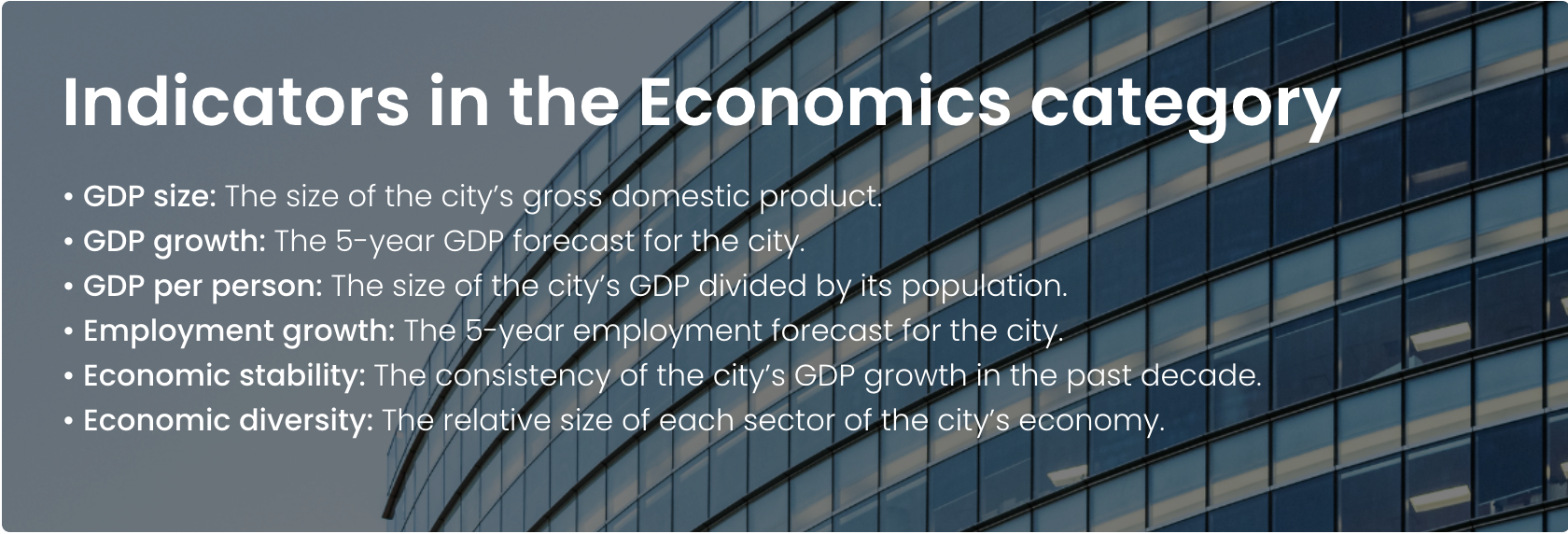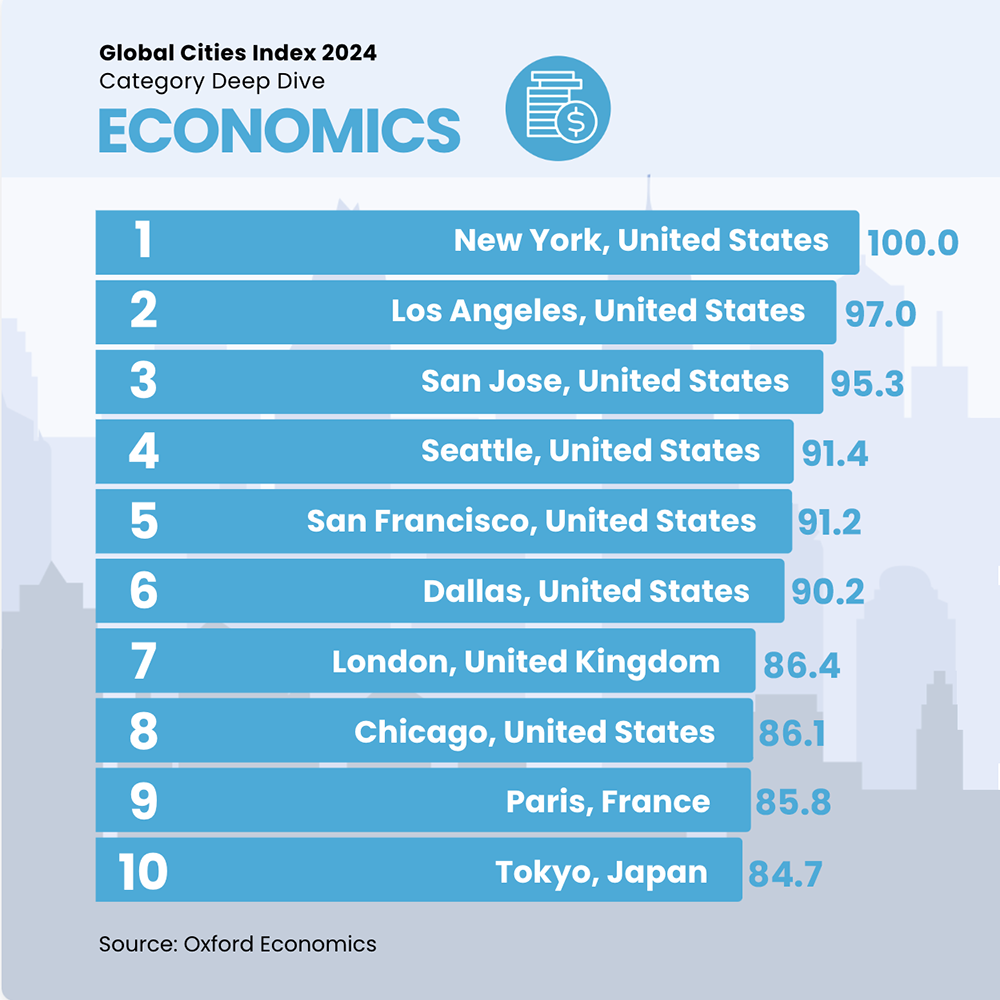By Anthony Bernard-Sasges | Senior Economist, Cities and Regions | Oxford Economics
Originally published by Oxford Economics
We recently launched our new Global Cities Index, which covers the 1,000 largest cities in the world and evaluates their performance in five categories: Economics, Human Capital, Quality of Life, Environment, and Governance. In Part 1 of our blog series, we covered the overall results of the Global Cities Index. Now, in Part 2, we take a closer look at the top performers in the Economics category.
The crucial role of the Economics category
A city’s economy plays an essential role in its prosperity and attractiveness to residents, businesses, and investors alike. As a fundamental aspect of urban development, economic vitality is key to a city’s wealth generation, employment opportunities, access to goods and services, and much more. But while GDP growth tends to be the single metric most often focused on, the rate at which a city’s economy is expanding is hardly the only (or in many cases, the most important) indicator by which to assess a city’s economy. So, in order to more comprehensively encapsulate the economic performance and potential of each of our 1,000 cities, we include six indicators in the Economics category:

These indicators measure the economic size, structure, and growth of each city, examining both historical performance and future potential. They acknowledge the multifaceted manner in which a city’s economy shapes its urban landscape and drives investment.
The top 10 cities in the Economics category
The cities topping the Economics category are the engines of the world economy. Seven of the top 10 are located in the United States, underscoring the country’s dominant economic role in the global marketplace. New York takes the top spot, as it has the largest city economy in the world by far: its GDP is nearly US$1 trillion larger than the next-biggest city economy (Tokyo). New York has also benefitted from stable economic growth in the decade preceding the Covid-19 outbreak. And although the city’s economy suffered more than many other American metros during the pandemic, it has rebounded strongly and its fortunes look positive for the future.
These are the Economics scores of the top cities:

Next come the Californian metros of Los Angeles and San Jose. Like New York, Los Angeles has one of the largest city economies in the world and experienced stable growth in the decade prior to the Covid-19 outbreak. San Jose, on the other hand, has a smaller economy in aggregate terms, but the city has the highest levels of GDP per person in the world, significantly dwarfing all other cities in the index.
Rounding out the top five cities are Seattle and San Francisco. Like San Jose, these two cities are major tech hubs, which gives them top scores in both the GDP per person and aggregate GDP size metrics. Seattle slightly outshines its more southernly peer due to its more diverse and stable economy. The final two US metros in the top 10 are Dallas at #6 and Chicago at #8. They follow a similar formula to that of other American cities at the top of the rankings by having some of the largest economies in the world, coupled with stable growth.
The three non-US cities leading the rankings in the Economics category are behemoths of the global economy in their own right. London, Paris, and Tokyo are all among the five largest metro economies in the world, but they tend to trail their American counterparts in terms of GDP per person. London and Paris benefit from being the primary economic centres of their respective countries. And they both have strong scores for economic stability (which isn’t the case for many smaller cities in the UK and France), highlighting their consistent contributions to the global economy.
Despite having the second-largest metro economy in the world and the most diverse economy of any city in the top 10, Tokyo takes the 10th spot in the Economics category. The Japanese capital is held back from an even stronger performance in this category due its GDP growth forecast. Out of our 1,000 cities, we only expect 36 to experience slower GDP growth than Tokyo over the next five years. Slow growth prospects are nothing new to Tokyo, so it is a testament to the city’s resiliency that it still sits in our global top 10 for the Economics category, beating out many other major cities.
The Global Cities Index scores cities based on how they are performing today. But there are several global trends that have the potential to disrupt these rankings in years to come. An uneven economic outlook across regions, driven by lingering inflationary concerns, debt sustainability issues, and heightened interest rates, could result in a significant reshuffling of the top cities in the Economics category next year.
About the Global Cities Index
The Oxford Economics Global Cities Index ranks the largest 1,000 cities in the world based on five categories: Economics, Human Capital, Quality of Life, Environment and Governance. Underpinned by Oxford Economics’ Global Cities Service, the index provides a consistent framework for assessing the strengths and weaknesses of urban economies across a total of 27 indicators. To our knowledge, this is the largest and most detailed cities index in the industry. Click here to download the full report.
About the Author

Anthony Bernard-Sasges is a senior economist. He primarily produces research and forecasts for cities in Canada and the Middle East & North Africa. Anthony holds a master’s degree in Development Economics from the University of Oxford and a bachelor’s degree in International Political Economics from Georgetown University.
The views and opinions expressed by blog authors are those of the authors and do not necessarily reflect the official policy or position of the International Association of Exhibitions and Events®. Any content provided by our bloggers or authors are of their opinion. All content provided on this blog is for informational purposes only. IAEE makes no representations as to the accuracy or completeness of any information on this site or found by following any link on this site. IAEE will not be liable for any errors or omissions in this information nor for the availability of this information.



